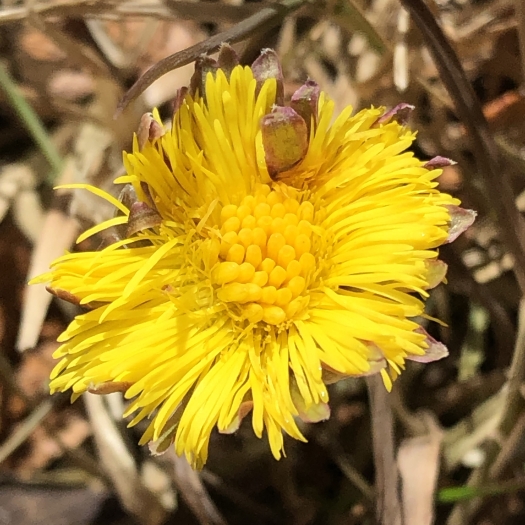Coltsfoot
(Tussilago farfara)
Coltsfoot (Tussilago farfara)
/
/

Marilyne Busque-Dubois
CC BY 4.0
Image By:
Marilyne Busque-Dubois
Recorded By:
Copyright:
CC BY 4.0
Copyright Notice:
Photo by: Marilyne Busque-Dubois | License Type: CC BY 4.0 | License URL: http://creativecommons.org/licenses/by/4.0/ | Rights Holder: Marilyne Busque-Dubois | Publisher: iNaturalist | Date Created: 2022-04-06T15:00:21Z |











Estimated Native Range
Summary
Tussilago farfara, commonly known as coltsfoot, is a perennial herbaceous plant native to a variety of habitats including riverbanks, damp forest clearings, and wet meadows in Europe, parts of Asia, and North Africa. It has also naturalized in parts of North America. Coltsfoot typically grows to a height of 10-30 cm with a spread of 15-30 cm. The plant is characterized by its bright yellow flowers that resemble dandelions and appear in early spring before the leaves. The flowers are borne on scaly stems and are highly attractive to early-season pollinators. After flowering, broad, heart-shaped leaves emerge, which were historically used for medicinal purposes.
Coltsfoot is valued for its early spring flowers, which can provide a splash of color when few other plants are in bloom. It is often used in wildflower gardens, for erosion control on banks, and in naturalistic plantings. In cultivation, coltsfoot prefers moist, well-drained soils and can tolerate partial shade, though it will also grow in full sun. While it is low-maintenance and can be drought-tolerant once established, gardeners should be cautious as it can become aggressive and spread through its rhizomes. It is important to control its spread to prevent it from becoming invasive outside its native range.CC BY-SA 4.0
Coltsfoot is valued for its early spring flowers, which can provide a splash of color when few other plants are in bloom. It is often used in wildflower gardens, for erosion control on banks, and in naturalistic plantings. In cultivation, coltsfoot prefers moist, well-drained soils and can tolerate partial shade, though it will also grow in full sun. While it is low-maintenance and can be drought-tolerant once established, gardeners should be cautious as it can become aggressive and spread through its rhizomes. It is important to control its spread to prevent it from becoming invasive outside its native range.CC BY-SA 4.0
Plant Description
- Plant Type: Herb
- Height: 1-1.5 feet
- Width: 3-6 feet
- Growth Rate: Moderate
- Flower Color: Yellow
- Flowering Season: Spring
- Leaf Retention: Deciduous
Growth Requirements
- Sun: Full Sun, Part Shade
- Water: Medium
- Drainage: Medium
Common Uses
Bee Garden, Erosion Control, Low Maintenance
Natural Habitat
Native to riverbanks, damp forest clearings, and wet meadows in Europe, parts of Asia, and North Africa, and naturalized in North America
Other Names
Common Names: Coltsfoot, Horse hoof, Foalfoot, Foal’s foot
Scientific Names: , Tussilago farfara, Cineraria farfara, Farfara radiata, Petasites farfara, Tussilago alpestris, Tussilago farfara f. pallida, Tussilago farfara var. duplicatolobatum, Tussilago farfara var. spinulifolia, Tussilago farfara var. spinulifolia
GBIF Accepted Name: